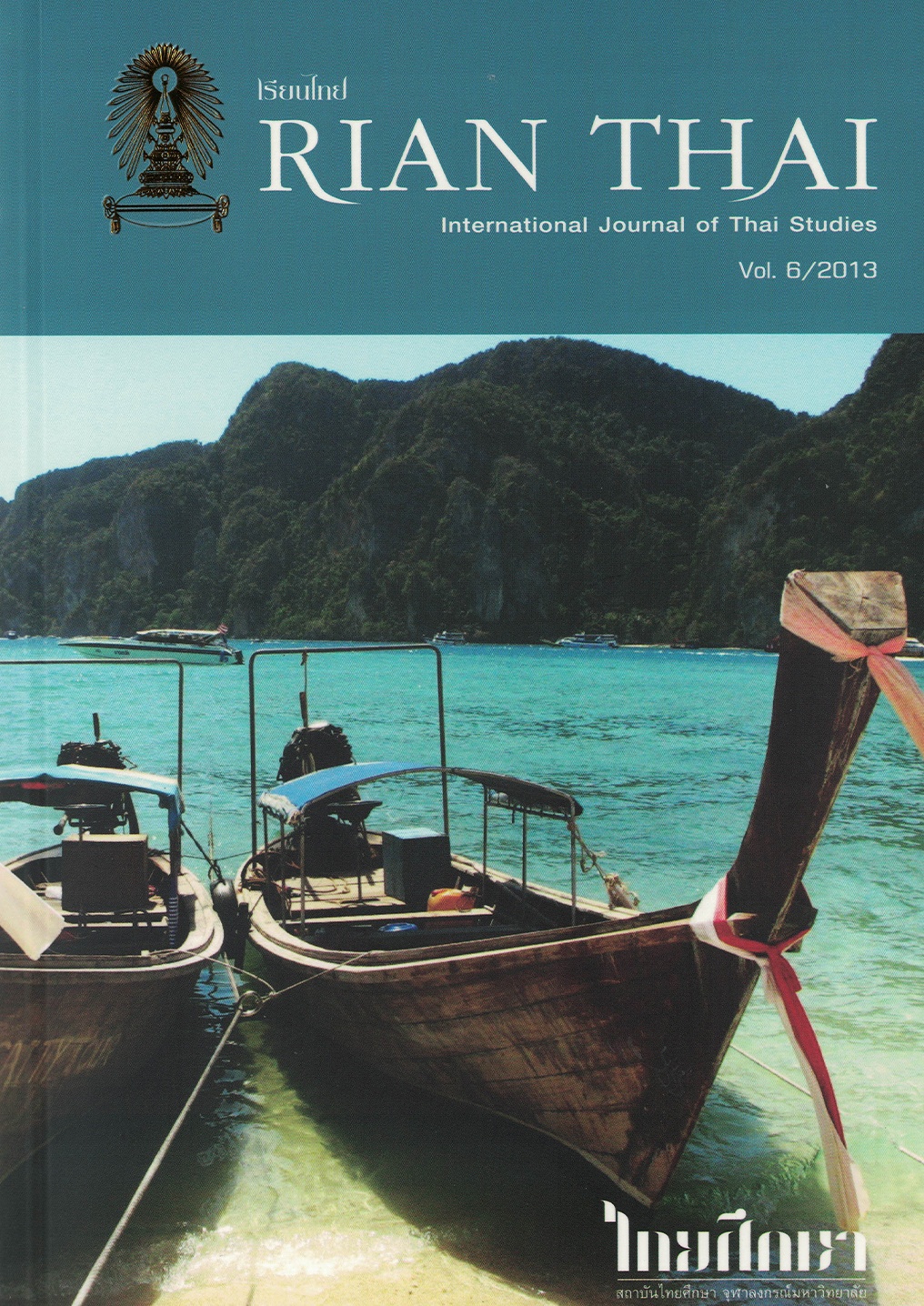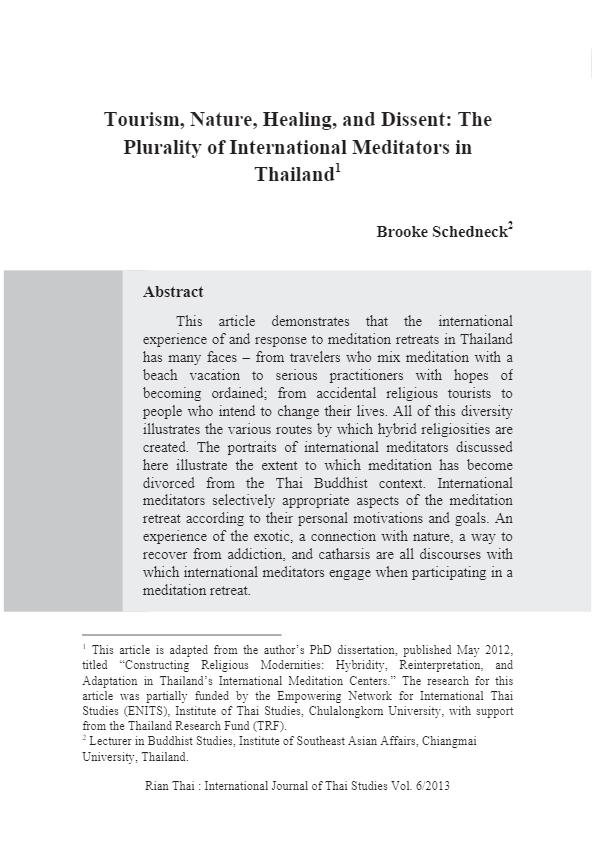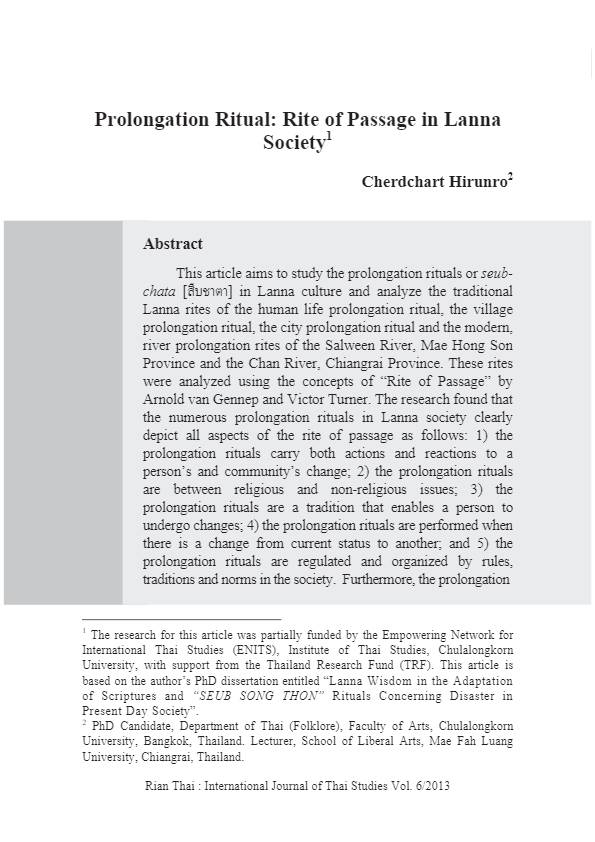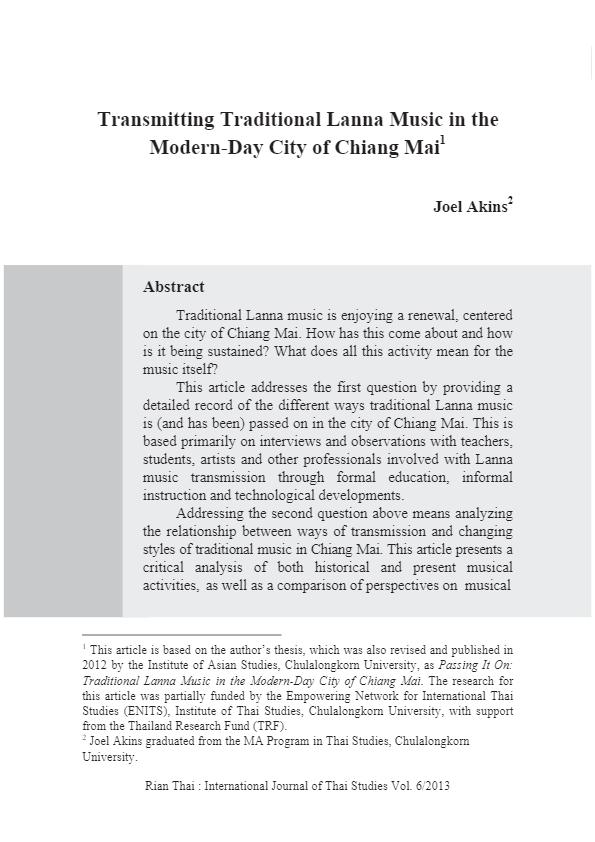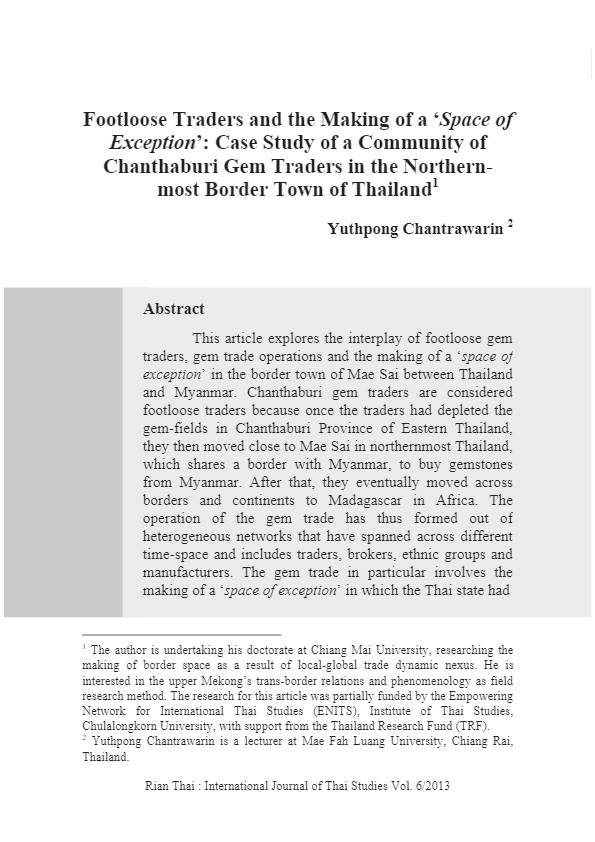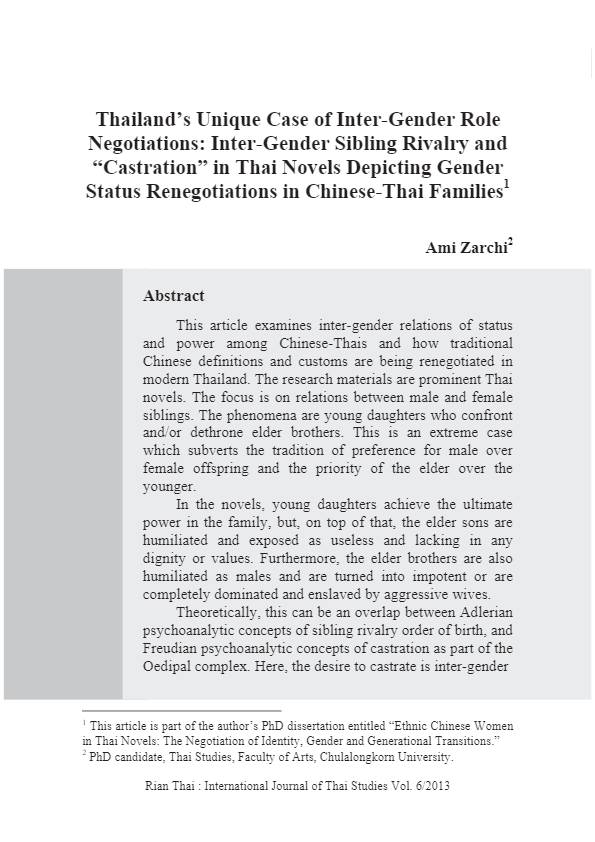Rian Thai - Volume 6/2013
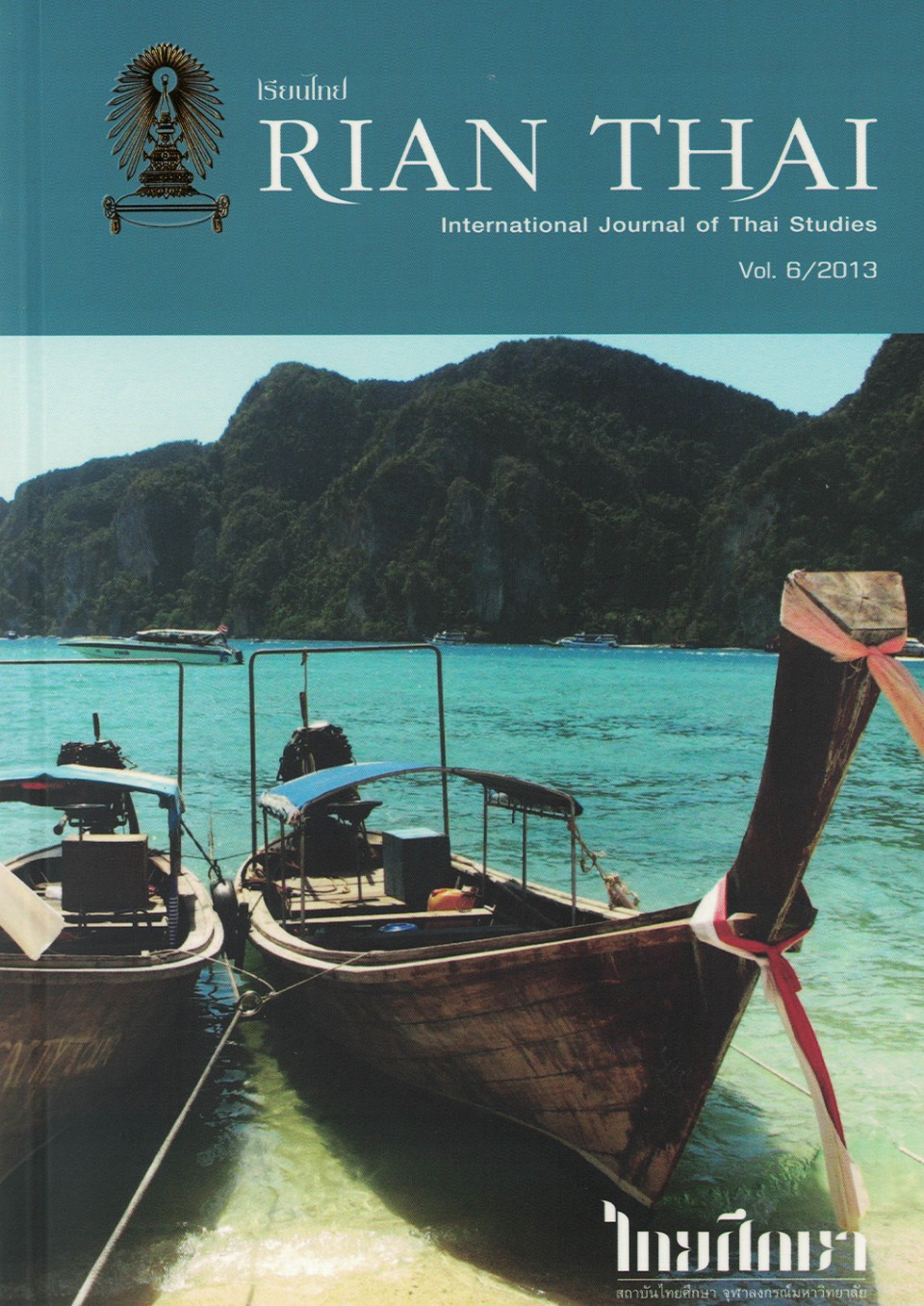
1) Tourism, Nature, Healing, and Dissent : The Plurality of International Meditators in Thailand / Brooke Schedneck
2) Prolongation Ritual : Rite of Passage in Lanna Society / Cherdchart Hirunro
3)The Role of Mindfulness Meditation and Aesthetic Virtue in the Transition from the Emptiness of Self to Social Engagement: Buddhadasa’s Appropriation of D. T. Suzuki’s Theory of Buddhist Enlightenment / Geoff Ashton
4) Transmitting Traditional Lanna Music in the Modern-Day City of Chiang Mai / Joel Akins
5) Rediffusion : History of Broadcasting and Chinese Society in Thailand, 1950S-1970s / Kornphanat Tungkeunkunt
6) Women Enter The ‘Public Sphere’ : Thailand’s Post-Revolutionary Period 1932-1956 / Natanaree Posrithong
7) The Role of Chinese Tea Shops in Promoting Chinese Tea Culture in Bangkok / Sakaorat Harnkarnchanasuwat
8) Compromised Margins : Rethinking Power, State and Village Relations in the Borderlands of Thailand and Lao PDR / Soimart Rungmanee
9) Endangered Thai Music Culture :The Current Situation of the khrueang sai pi chawa Ensemble / Supeena Insee Adler
10) Footloose Traders and the Making of a ‘Space of Exception’ : Case Study of a Community of Chanthaburi Gem Traders in the Northern-most Border Town of Thailand / Yuthpong Chantrawarin
11) Thailand’s Unique Case of Inter-Gender Role Negotiations : Inter-Gender Sibling Rivalry and “Castration” in Thai Novels Depicting Gender Status Renegotiations in Chinese-Thai Families / Ami Zarchi
Tourism, Nature, Healing, and Dissent : The Plurality of International Meditators in Thailand
Brooke Schedneck
Abstract
This article demonstrates that the international experience of and response to meditation retreats in Thailand has many faces – from travelers who mix meditation with a beach vacation to serious practitioners with hopes of becoming ordained; from accidental religious tourists to people who intend to change their lives. All of this diversity illustrates the various routes by which hybrid religiosities are created. The portraits of international meditators discussed here illustrate the extent to which meditation has become divorced from the Thai Buddhist context. International meditators selectively appropriate aspects of the meditation retreat according to their personal motivations and goals. An experience of the exotic, a connection with nature, a way to recover from addiction, and catharsis are all discourses with which international meditators engage when participating in a meditation retreat.
(Published in Rian Thai: International Journal of Thai Studies, Volume 6/2013, Page 1-24)
Full Text : Download
Prolongation Ritual : Rite of Passage in Lanna Society
Cherdchart Hirunro
Abstract
This article aims to study the prolongation rituals or seubchata [สืบชะตา] in Lanna culture and analyze the traditional Lanna rites of the human life prolongation ritual, the village prolongation ritual, the city prolongation ritual and the modern, river prolongation rites of the Salween River, Mae Hong Son Province and the Chan River, Chiangrai Province. These rites were analyzed using the concepts of “Rite of Passage” by Arnold van Gennep and Victor Turner. The research found that the numerous prolongation rituals in Lanna society clearly depict all aspects of the rite of passage as follows: 1) the prolongation rituals carry both actions and reactions to a person’s and community’s change; 2) the prolongation rituals are between religious and non-religious issues; 3) the prolongation rituals are a tradition that enables a person to undergo changes; 4) the prolongation rituals are performed when there is a change from current status to another; and 5) the prolongation rituals are regulated and organized by rules, traditions and norms in the society. Furthermore, the prolongation ritual is very meaningful and profoundly significant to Lanna society, especially during and after a critical period, by allowing the community to escape from chaotic and insecure conditions, and return to normality.
(Published in Rian Thai: International Journal of Thai Studies, Volume 6/2013, Page 25-39)
Full Text : Download
The Role of Mindfulness Meditation and Aesthetic Virtue in the Transition from the Emptiness of Self to Social Engagement: Buddhadasa’s Appropriation of D. T. Suzuki’s Theory of Buddhist Enlightenment
Geoff Ashton
Abstract
At the heart of Buddhism is the social-moral imperative to alleviate the suffering of all beings. But the notion of a socially engaged Buddhist rests on precarious grounds. Buddhist philosophy contends that human individuals do not really exist – the human person is just a fabrication of the mind. Buddhist spiritual practices, meanwhile, convey direct experience of the illusoriness of individual persons (including oneself) and emphasize detachment from worldly involvements. How, then, can a Buddhist ease the suffering of other persons if he has renounced ownership of his own self – either through withdrawal into monastic life or blind allegiance to an external agency (e.g., a political institution)?
This article responds to this puzzle by first examining how Buddhist selflessness is not just a theoretical problem, but a practical one as well: the article considers the social-moral and political problems associated with the Buddhist philosophy of activism of D. T. Suzuki, one of the leading voices of socially engaged Buddhism who used Buddhism in order to rally support for the purposes of a morally corrupt Japanese Empire. The article then analyses the influence of Suzuki upon the 20th century Thai Buddhist philosopher, Buddhadasa, and poses the question: is Buddhadasa’s version of socially engaged Buddhism subject to the same criticisms as Suzuki’s call to action? Finally, the article examines key differences between the meditation practices of Suzuki and Buddhadasa, and argues that anapanasati (the form of mental cultivation taught by Buddhadasa) develops certain aesthetic virtues (e.g., loving kindness or metta) that (a) get over-looked in zazen (emphasized by Suzuki) and (b) enable the practitioner to become an agent of social change who positively, yet selflessly, attends to the needs of others.
(Published in Rian Thai: International Journal of Thai Studies, Volume 6/2013, Page 41-61)
Full Text : Download
Transmitting Traditional Lanna Music in the Modern-Day City of Chiang Mai
Joel Akins
Abstract
Traditional Lanna music is enjoying a renewal, centered on the city of Chiang Mai. How has this come about and how is it being sustained? What does all this activity mean for the music itself?
This article addresses the first question by providing a detailed record of the different ways traditional Lanna music is (and has been) passed on in the city of Chiang Mai. This is based primarily on interviews and observations with teachers, students, artists and other professionals involved with Lanna music transmission through formal education, informal instruction and technological developments.
Addressing the second question above means analyzing the relationship between ways of transmission and changing styles of traditional music in Chiang Mai. This article presents a critical analysis of both historical and present musical activities, as well as a comparison of perspectives on musical change in the North in order to show how the expansion of musical transmission in Chiang Mai has worked in tandem with the increase in variety of Lanna musical styles in recent times.
(Published in Rian Thai: International Journal of Thai Studies, Volume 6/2013, Page 63-97)
Full Text : Download
Rediffusion : History of Broadcasting and Chinese Society in Thailand, 1950S-1970s
Kornphanat Tungkeunkunt
Abstract
Rediffusion (Song Siang Thang Sai [ส่งเสียงทางสาย] in Thai, or Lide Husheng in Chinese) was the sole wire-transmitted radio station in Thailand that legally broadcasted in the Chinese language. Established in the UK in 1928, known as Broadcast Relay Services, Rediffusion came to the British colonies, Hong Kong, Singapore and Malaya, in the late 1940s. In the postwar period, Rediffusion was introduced to Thailand where huge Chinese communities lived. Rediffusion had a variety of programmes including news and entertainment, yet depended considerably on music and drama. This article aims to examine the making of Rediffusion in Thailand and its features. This article argues that the making of Rediffusion was primarily based on political concerns. As a state-controlled semi-private enterprise, Thai Rediffusion Company worked closely with the government. Rediffusion, however, seems to have played a crucial role, both social and cultural. During the cold war, Rediffusion became a channel for the Chinese in Thailand to maintain ties with Chinese agencies, Hong Kong and Taiwan, and other Chinese communities in Southeast Asia, when connection with the PRC was discouraged.
(Published in Rian Thai: International Journal of Thai Studies, Volume 6/2013, Page 99-135)
Full Text : Download
Women Enter The ‘Public Sphere’ : Thailand’s Post-Revolutionary Period 1932-1956
Natanaree Posrithong
Abstract
By the revolutionary year of 1932, elite Siamese women were represented in the political domain of the post-absolutist regime. They became more involved in the public sphere, participated in politics, and eventually served as agents of nationalism in the continuous era of state-building. In order to understand the pivotal role of elite women in the politics of the post-absolutist regime, this study uses the voices of the wives of politicians – La-iad Phibunsongkhram and Phunsuk Banomyong – to analyse the enhanced state’s recognition of women in the nation-building process and the promotion of greater political participation of women beyond the aristocratic class barrier.
(Published in Rian Thai: International Journal of Thai Studies, Volume 6/2013, Page 137-161)
Full Text : Download
The Role of Chinese Tea Shops in Promoting Chinese Tea Culture in Bangkok
Sakaorat Harnkarnchanasuwat
Abstract
During the current period of time, there are many tea shops that have recently opened and some old tea shops have been developed to meet the global change. Moreover, there are Chinese restaurants at five-star hotel that have been opened and developed by adding various kinds of Chinese tea to their menu to catch up with the re-flourish of Chinese cultural from the end of twentieth century until the present time.
This article is an attempt to study the role of Chinese tea shops in promoting Chinese tea culture with an assumption that they have a function to provide a public space for people who love to consume Chinese tea. These shops gathered Chinese tea drinkers and Chinese tea porcelain lovers to share their knowledge of Chinese tea, Chinese tea porcelain collecting, and other topics.
The research reveals that some Chinese tea shops not only sell Chinese tea leaves and Chinese tea, but act as a public space for customers to come to learn Chinese tea culture and Chinese tea related things. Although Chinese tea originated from China, when it spread throughout the world, each country developed Chinese tea as their unique beverage. When we consider Bangkok nowadays, we find that we have different kinds of tea shops; for instance, English tea shops, such as Witthard of Chelsea; Japanese tea shops, such as Cha Ho, and Chinese tea shops, such as Ong’s Tea. These tea shops have tried to create their own brands and improve the uniqueness of English tea, Japanese tea, or Chinese tea. The Chinese tea shops, such as Ong Ew Kee, Ong’s Tea, Three Horses, and Ju Rui Tang, bear the function of promoting Chinese tea culture and public space for people who love to consume Chinese tea.
(Published in Rian Thai: International Journal of Thai Studies, Volume 6/2013, Page 163-180)
Full Text : Download
Compromised Margins : Rethinking Power, State and Village Relations in the Borderlands of Thailand and Lao PDR
Soimart Rungmanee
Abstract
This article, which provides a new approach to exploring the relationship between state power and borderland communities in Northeast Thailand and Laos, argues that the state law and regulations governing the cross-border migration of agricultural workers from Laos to Thailand has been re-negotiated by local officials and villagers from both sides of the borderlands. This article suggests that the spatial characteristics of Northeast Thailand and the Lao borderlands, including their similarities of historical ties, languages, cultures, and geographical proximity, are conducive to re-negotiation of cross-border policies by state authorities and villagers. Case studies of cross-border employment and everyday life in Northeast Thailand and Lao borderlands portray a compromised form of engagement between the state and villagers.
(Published in Rian Thai: International Journal of Thai Studies, Volume 6/2013, Page 181-201)
Full Text : Download
Endangered Thai Music Culture : The Current Situation of the khrueang sai pi chawa Ensemble
Supeena Insee Adler
Abstract
The khrueang sai pi chawa (KSPC, “Thai stringed instruments with Javanese oboe”) ensemble in Central Thai society is a unique ensemble for its repertoire, its tuning, and its contemporary cultural context. In 2012, only one institution maintains a complete professional ensemble, performing only for special occasions. In my ongoing fieldwork research in Thailand, I have found that this special ensemble has a long history and complicated circumstances involving both the royal literature Inao and the politics of authority in its transmission. Khrueang sai pi chawa is very highly regarded, but rarely performed among Thai musicians. I consider it to be an endangered musical form, in part because of the very strict custom that the only musicians able to perform are those who have had direct contact and studied with teachers who played in khrueang sai pi chawa, and they must receive special permission to perform. This permission can only come from those who have played KSPC in the past, and very few continue to perform actively. Another factor is that few Thai musicians appreciate or fully understand the function of this unique ensemble. From my extensive interviews, I found that knowledge of KSPC is limited at present to only a few musicians who assert the authority to perform and teach KSPC to the next generation, and this authority emanates from their position within the Music Division of the Fine Arts Department of the Thai government in Bangkok.
(Published in Rian Thai: International Journal of Thai Studies, Volume 6/2013, Page 203-226)
Full Text : Download
Footloose Traders and the Making of a ‘Space of Exception’ : Case Study of a Community of Chanthaburi Gem Traders in the Northern-most Border Town of Thailand
Yuthpong Chantrawarin
Abstract
This article explores the interplay of footloose gem traders, gem trade operations and the making of a ‘space of exception’ in the border town of Mae Sai between Thailand and Myanmar. Chanthaburi gem traders are considered footloose traders because once the traders had depleted the gem-fields in Chanthaburi Province of Eastern Thailand, they then moved close to Mae Sai in northernmost Thailand, which shares a border with Myanmar, to buy gemstones from Myanmar. After that, they eventually moved across borders and continents to Madagascar in Africa. The operation of the gem trade has thus formed out of heterogeneous networks that have spanned across different time-space and includes traders, brokers, ethnic groups and manufacturers. The gem trade in particular involves the making of a ‘space of exception’ in which the Thai state had been more flexible in its surveillance of Mae Sai border space. Subsequently, the ‘space of exception’ could tap the large amount of gem flows from the Myanmar hinterland by containing its ethnic gem caravans in a restricted space. This space also conferred privileges onto Chanthaburi gem traders. The gem trade was a major economic activity of Mae Sai in 1993-2003, and, in particular, during its heyday from 1995-1996.
(Published in Rian Thai: International Journal of Thai Studies, Volume 6/2013, Page 227-250)
Full Text : Download
Thailand’s Unique Case of Inter-Gender Role Negotiations : Inter-Gender Sibling Rivalry and “Castration” in Thai Novels Depicting Gender Status Renegotiations in Chinese-Thai Families
Ami Zarchi
Abstract
This article examines inter-gender relations of status and power among Chinese-Thais and how traditional Chinese definitions and customs are being renegotiated in modern Thailand. The research materials are prominent Thai novels. The focus is on relations between male and female siblings. The phenomena are young daughters who confront and/or dethrone elder brothers. This is an extreme case which subverts the tradition of preference for male over female offspring and the priority of the elder over the younger.
In the novels, young daughters achieve the ultimate power in the family, but, on top of that, the elder sons are humiliated and exposed as useless and lacking in any dignity or values. Furthermore, the elder brothers are also humiliated as males and are turned into impotent or are completely dominated and enslaved by aggressive wives.
Theoretically, this can be an overlap between Adlerian psychoanalytic concepts of sibling rivalry order of birth, and Freudian psychoanalytic concepts of castration as part of the Oedipal complex. Here, the desire to castrate is inter-gender rather than intra-gender, and it derives its motives from a rivalry of siblings, subverting not only traditional male superiority, but also superiority derived from place in the order of birth.
(Published in Rian Thai: International Journal of Thai Studies, Volume 6/2013, Page 251-273)
Full Text : Download
